|
Philadelphia Memories - Part X
The View From North Broad Street: This photo shows 1953 Philadelphia traffic on N. Broad Street:
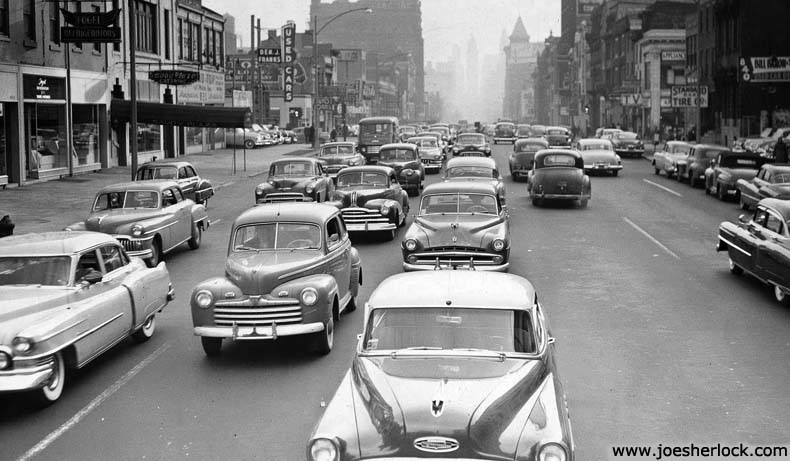
The Old Motor noted that a number of similar surviving images containing views of traffic in large cities were taken for street and highway departments to document traffic patterns for later study in an effort to ease congestion. The image above was photographed at the intersection of North Broad and Poplar Streets in mid-afternoon on July 18, 1953, looking south.
The vast majority of the automobiles on Broad Street are postwar, and Ben J. Franks' Used Car lot is visible on the left-hand side of the thoroughfare. The photo looks south from Poplar St., just south of Girard Avenue. At left, the light-colored car is a 1951 Cadillac four-door sedan. Behind it is a 1950 DeSoto. In the next lane is a 1947 Ford; behind it is a 1948 Pontiac. In the foreground of the next lane is a two-tone 1953 Buick. Behind it is a 1952 Dodge. In the center of the photo is a fog or smog-shrouded City Hall.
At left is Fogel Refrigerators (Fogel Commercial Refrigeration Co.), Savoy Plaza Catering, and Ben J. Frank's Used Cars.
Fogel USA was founded in 2003, but Fogel Refrigeration, its original foundation, dates back to the late 1800s. Mr. Fogel's son, William, became head of Fogel Refrigeration and expanded from Philadelphia to the Dominican Republic, reaching to Puerto Rico. William's brother, Albert was the founder of Howard/McCray, and both companies eventually merged into one based in Philadelphia. Fogel USA now carries one of the most extensive lines of commercial refrigeration, ranging from glass door refrigerators, bottle coolers, ice merchandisers and much more.
At right is Bill Baron Used Cars at 840 N. Broad St. Broad Street Tires is now located at that address, perhaps a derivative of Standard Tire Co. which, in the photo, is next door to Baron. (posted 12/4/18, permalink)
No Bucket Truck Needed Here: This 1910 Philadelphia Electric Co. streetlight maintenance vehicle made light bulb changing a snap:
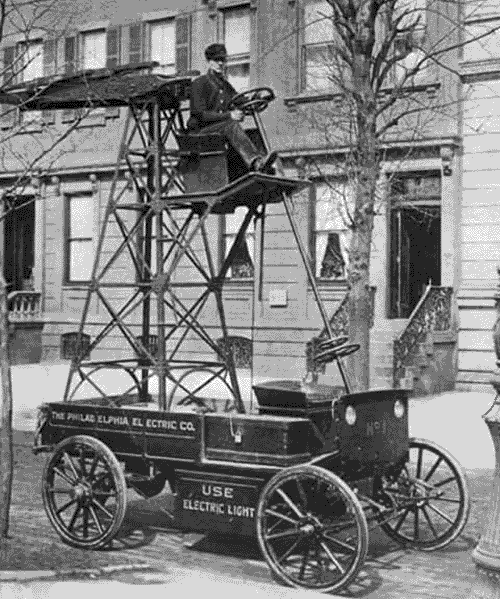
No ladder required. (hat tip: Jesse Bowers of 'Just A Car Guy') (posted 10/2/18, permalink)
Mayfair Street Scene: A photo, taken March 11, 1942, shows Frankford Avenue at Cottman Avenue in the Mayfair section of Northeast Philadelphia.
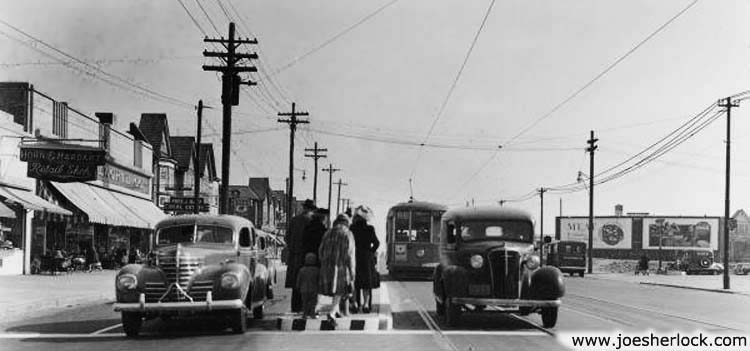
The sign at left is for a sign for Horn and Hardart Retail Shop. The car at left is a 1939 Plymouth sedan with a unique triangular center bumper guard. Next to the Plymouth is a concrete loading island for the Route 66 trolley car which can be seen approaching the stop. It must have been a cold day, because the woman in the foreground is wearing a fur coat. On the other side of the island is a dark-colored 1937 Chevrolet panel van.
Trolleys were replaced with trolleybuses (trackless trolleys) in 1955. The 66 trackless trolley line still runs along Frankford Avenue and connects with the Frankford El at Bridge Street Terminal. (posted 9/26/18, permalink)
Milk Run: During World War II, many jobs formerly performed by men were taken over by women. In these photos, Mrs. Helen Joyce, "one of the many women who now work for the Supplee-Wills-Jones Milk Co.," is making morning deliveries of milk and milk products to individual homes in Bryn Mawr, PA, a tony Philadelphia suburb.
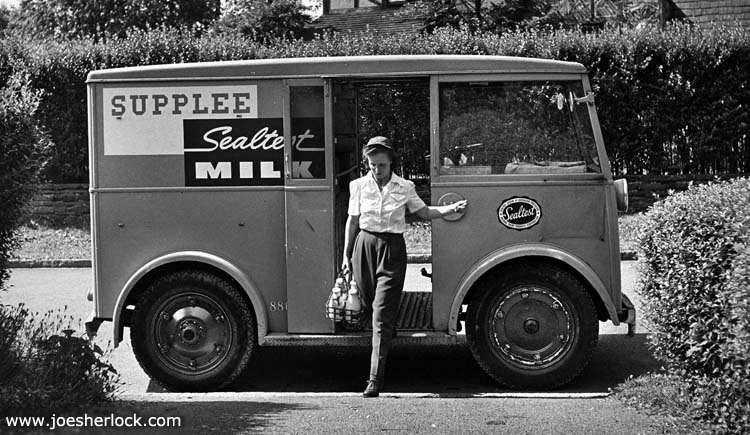
At the time of this June 1943 photo, she had one child and her husband was a seaman first-class in the Navy.
Mrs. Joyce was piloting a Walker electric delivery van. Walker Electric Trucks were battery-powered vehicles built from 1907 to 1942 in Chicago, Illinois and Detroit, Michigan. Matchbox produced a scale model (approximately 1:60 scale) 1919 Walker Electric Parcel Van as part of its Yesteryear series in 1985 in Harrod's Ltd. (the iconic London department store) livery. (posted 9/12/18, permalink)
Riding The Big Red Cars: The Red Arrow Trolley System served the suburbs west of Philadelphia in Delaware and Chester Counties and was operated by the Philadelphia Suburban Transportation Company.
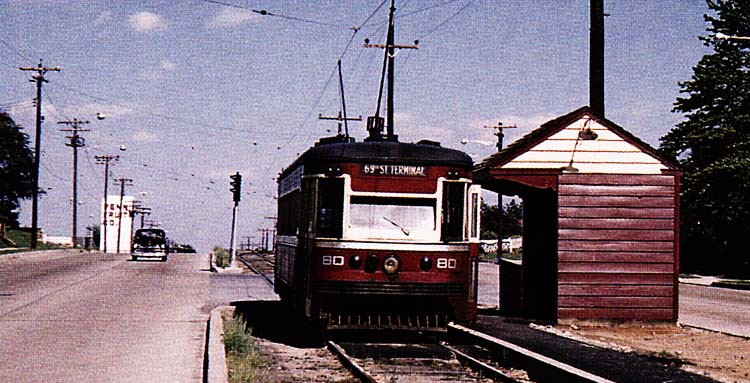
Most of its trolleys were bigger and heavier than the ones in Philadelphia proper and many ran on their own right of way on the side of major roads.
When I was almost five years old, I took my first Red Arrow trip from the PTC's 69th Street terminal in Upper Darby to Immaculata (near Malvern, PA in Chester County) with my mom. She was visiting one of her cousins - an Immaculate Heart of Mary nun who was terminally ill and being given hospice care at the convent. We returned a few months later for her funeral and burial on Immaculata College's grounds in August, 1948. We traveled by car on that occasion with my dad behind the wheel of our blue 1936 Ford Tudor.
The Philadelphia Suburban Transportation Company was an operator of buses and streetcars. It was incorporated in 1936 as a successor to the Philadelphia & West Chester Traction Co., taking over as well several leased companies. It used the name Red Arrow Lines as well as its own, sometimes emphasizing one name and sometimes the other.
The company's operations were taken over by SEPTA (Southeastern Pennsylvania Transportation Authority) in 1970. (posted 8/8/18, permalink)
Down At The Shore - 2018 Edition: My brother recently returned from a Wildwood Crest, NJ vacation. Knowing that my wife and I enjoy all things Jersey shore-related, he sent us numerous editions of those pulp giveaway shoppers' guides to the New Jersey shore. I reported on the 2017 editions here. My 2016 report is posted here. The 2015 report is here; the 2014 survey can be found here.

I love the tacky ads, the unique offerings and the catchy, memorable and sometimes outrageous business names. Most businesses at the Jersey Shore have only three months to make their money for the year. So, these firms must promote, promote and promote and be clever and creative about it. There's lots of mid-Atlantic chutzpah in the ads for various establishments and, those laid-back and often-failing businesses in the Pacific Northwest could learn much from it. Here are some things that caught my eye in 2018:
• 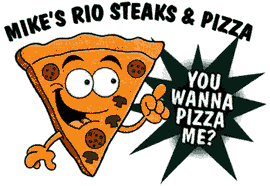 Mike's Rio Steaks & Pizza, located in the Rio Grande section of Cape May County uses the slogan: 'You Wanna Pizza Me?' As with many of the area restaurants, Mike's offers Early Bird specials for geezers between 3 and 6 pm. For $8.95, you have your choice of spaghetti and meatballs, open-faced turkey sandwich, meatloaf with French fries or chicken parmigiana. Included in the meal is a salad, garlic bread and dessert. Mike's Rio Steaks & Pizza, located in the Rio Grande section of Cape May County uses the slogan: 'You Wanna Pizza Me?' As with many of the area restaurants, Mike's offers Early Bird specials for geezers between 3 and 6 pm. For $8.95, you have your choice of spaghetti and meatballs, open-faced turkey sandwich, meatloaf with French fries or chicken parmigiana. Included in the meal is a salad, garlic bread and dessert.
• The New Jersey shore is, as you'd expect, full of seafood restaurants. Wildwood is a favorite destination for South Philly Italians and their suburban descendents, so there is a plethora of Italian restaurants. In fact, this year's North Wildwood Italian-American Festival had former teen idol Bobby Rydell as the Grand Marshal. There was a Little Miss Italy contest and, at the risk of stereotyping, I must point out that there were meatball relay races.
• Joey M's La Piazza Cucina in Wildwood offers a five-course dinner for two with a bottle of wine for $60.
• Little Italy in Wildwood offers a 4-5 pm Early Bird - a complete dinner for $14.50 with over a dozen entrees listed. Many restaurants start their Early Birds at 3 pm. People get hungry after walking the Boardwalk.
• Big Time Vending of Wildwood ran ads in several papers, offering free installation and service. Big deal. When I had my plastics manufacturing business, vending machine companies gave us a piece of the action too, based on sales. We used the money - which was substantial - for employee parties and such.
• Morey's Piers is a classic seaside amusement park, family owned and operated since 1969. It has over 100 rides and attractions, including three amusement piers and two beachfront waterparks. The Giant Wheel is Morey's 156-foot tall Ferris wheel. In the early mornings of the summer, Morey's offers Breakfast In The Sky, "a picnic in the sky complete with white linens and culinary delights" on the Giant Wheel.
• 5 De Mayo is a Mexican restaurant in Cape May. I guess New Jersey people don't know the word Cinco.
• There's a new ice cream parlor in the Rio Mall on Route 9. The name: Game of Cones.
• Hot Dog Tommy's in Cape May uses the slogan: 'Relish today, Ketchup Tomorrow'.
• Beefie's in North Wildwood offers "hand carved, hot beef, pork and ham plus veggie sandwiches." Go figure.
• The Milky Way, located at The Villas, offered 'Tee For $2 on Tuesdays'.
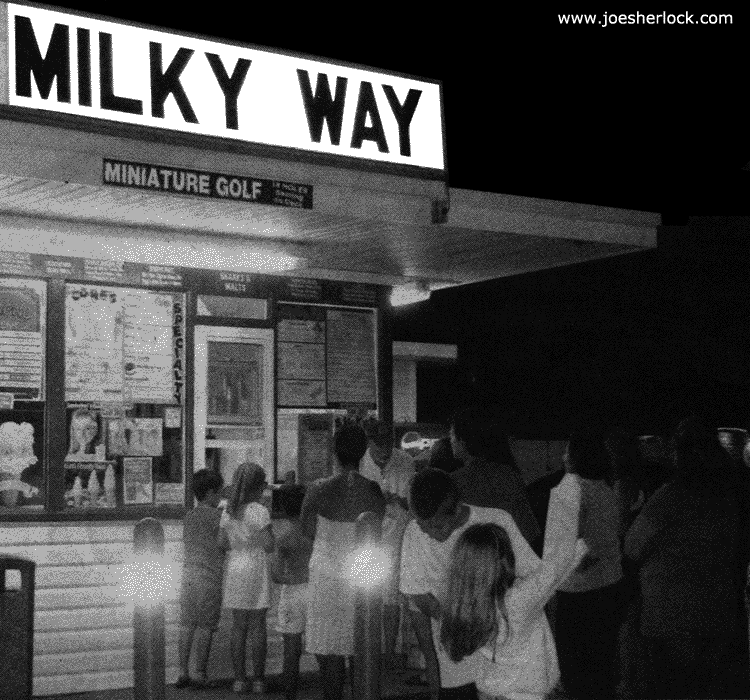
The ice cream and miniature golf emporium opened in 1965. It looks like many such places from the 1950s that dotted the Eastern Seaboard.
• Many places have $2 and $3 beer specials - something unheard of around here.
• Westside Meats in Rio Grande offers USDA first-cut fillet mignon for $9.95/lb. Tips - $4.99/lb. Foot-long hoagies: $4.99 each or two for $8.00.
• On Tuesdays, The Deck in Cape May serves $2 tacos and $4 margaritas.
• Ship n' Shore in Wildwood offers a cheese steak with French fries as Monday's special as well as "Happy Hour Prices - All Day, Every Day."
Gotta love the Jersey Shore; there's nothing quite like it. (posted 7/25/18, permalink)
City Of Parks (and a sports car or two): To many, Philadelphia is known as the City of Parks. Look around certain spots and you'll find greenery everywhere: Fairmount Park, Cobbs Creek Park, Pennypack Park, Wissahickon Valley Park, Morris Arboretum, Rittenhouse Square, Burholme Park, Northwood Park and many more.
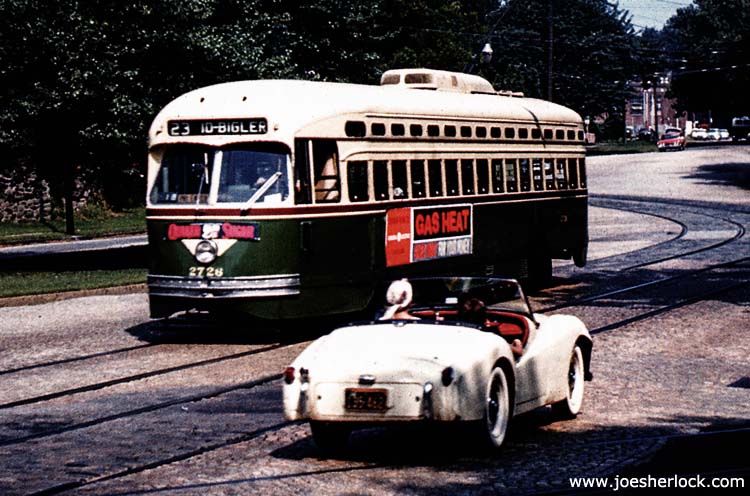
This southbound Rte. 23 trolley is on Germantown Avenue at Mermaid Lane Loop - an area with lots of foliage. The photo, taken in August 1960 at Cresheim Valley Drive, includes a white Triumph TR3 British roadster. The sports car is probably a 1955 or '56 model because it lacks exterior door handles.
The PTC streamliner trolley has a Quaker Sugar banner ad on its front and an advertisement promoting the use of gas heat on the side. (posted 7/9/18, permalink)
Remembering Sunken Gardens: I've previously written about long-gone Philadelphia restaurants, including two downtown establishments: Gaetano's and Bookbinders. I had patronized both as an adult.
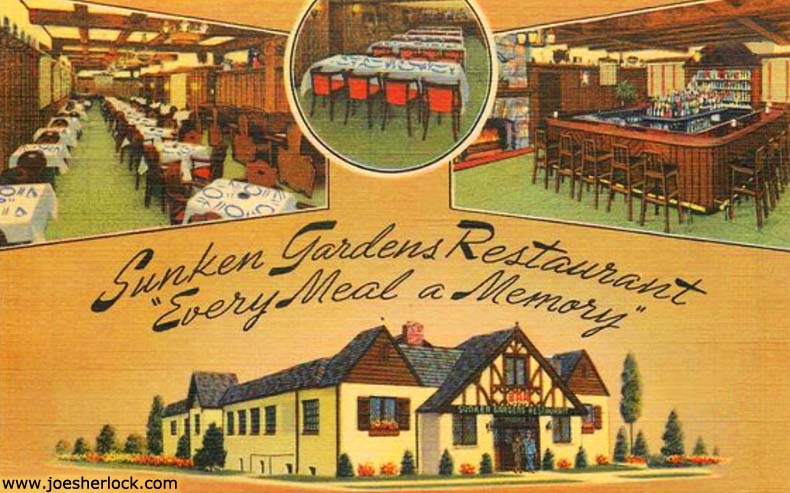
One memorable restaurant filed in a dusty corner of my brain was Sunken Gardens, located at the intersection of Cheltenham Avenue and Limekiln Pike at the northern edge of the city. In our family, Sunken Gardens was a place for special occasions. I have a vivid memory of dining there with my parents, grandmother, aunts and uncles when I was 5 or 6 years old. I was very impressed with the decor and the extensive menu choices. Sunken Gardens slogan - 'Every Meal A Memory' - certainly rang true for me. The English-cottage-style architecture was novel for a Philadelphia restaurant.
|
|
Cars lined up at a Texaco station in Philadelphia in 1942 or so for their ration of gasoline. The first vehicle is a 1940 Plymouth sedan. Two billboards can be seen in the background. The first is for Swan Floating Soap (a competitor to Ivory soap) that is "baby gentle." The second billboard advertises Sunken Gardens Restaurant, with an arrow indicating that the establishment is located only three minutes ahead.
|
Sunken Gardens opened in 1937 and was affiliated with the Samson House, a restaurant located at 1302-04 Sansom Street in downtown Philadelphia. A 1952 Sunken Gardens menu lists beer, wine and cocktails, including Michelob on draught, Lowenbrau by the bottle, a Manhattan for 50¢, daiquiris - 55¢, Cresta Blanca or Christian Bros. wines, a half-bottle of Gotham champagne for $3.50 and 25¢ for a glass of house wine (Tokay, claret or Rhine wine).

The cocktail portion of the menu had an illustration of dancing glasses and bottles.
The same menu offered various soups: Philadelphia pepper pot, Manhattan clam chowder, snapper, consume Vermicelli or French onion at prices ranging from 15 to 50¢.
The extensive menu had a large selection of main dishes, including lobster, beef, steaks, pigs knuckles, Lobster Thermador, breaded milk-fed veal cutlet with tomato sauce as well as calves brains saute Bismark. A broiled prime sirloin steak complete dinner with french fries and onions was priced at $2.90. A whole live Maine dinner with drawn butter cost $2.25. Chile con carne over rice was 50¢. Desserts included assorted home made pies, rice pudding, chocolate fudge cake, chocolate nut sundae, eclair with chocolate sauce, Boston cream pie.
There was also a Thursday dinner special: baked meatloaf with mushroom sauce. Dinner included soup, Harvard beets, whipped potatoes, salad, hot rolls, tea or coffee, and chocolate whipped cream pie - all for $1.00.
Sunken Gardens closed in the 1970s. Samson House - which also sported a timbered English facade - is long-gone as well; Google Street View shows a multi-story parking garage at the address. (posted 6/19/18, permalink)
Derham Body Co. - Coachbuilders To The World: Headquartered in Rosemont, PA (a Main Line suburb of Philadelphia), a custom coachbuilding company was founded by Irish wheelwright Joseph Derham in 1887 to make carriages for the well-to-do. As automobiles became popular, Derham provide bodies for cars for their wealthy clients.
Derham quickly developed a reputation for fine quality, durable bodywork ... (more >>>)
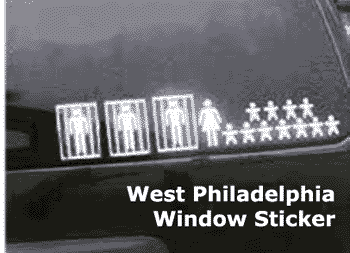 The 30 Blocks: I did not remember this phrase. Referenced in an article posted on The Burning Platform, it is code for the most-blighted 30-block area in West Philadelphia. The 30 blocks run from 69th Street to 39th Street. The 30 Blocks: I did not remember this phrase. Referenced in an article posted on The Burning Platform, it is code for the most-blighted 30-block area in West Philadelphia. The 30 blocks run from 69th Street to 39th Street.
The article described a murder, noting that it was "just another normal day in West Philly on the 30 Blocks. ... Nothing changes in West Philly. More bastard children are produced, more murders are committed, more taxpayer dollars are allocated to keep these people enslaved in welfare and squalor, and the public schools matriculate ignorant functionally illiterate idiots into society. The infrastructure will continue to crumble as their culture continues to deteriorate."
It should be noted that notorious murderer and serial abortionist Kermit Gosnell operated his "clinic" within The 30 Blocks.
"Notice the filth, trash and lack of people rushing to their jobs. The bars, fast food joints, and hookah joints are the only forms of commerce among the rat-infested crumbling boarded up hovels." Ghettos are ignored, patronized by politicians at election time and generally looked on with a mix of disdain and fear, much like 18th Century leper colonies.
It didn't used to be this way. My paternal grandparents and other relatives once lived in the very nice working-class neighborhood of West Philadelphia. My grandparents moved from South Philly to West Philly in the 1920s and remained in their Catherine Street home (between 55th and 56th Streets) until their deaths in the early '40s. My uncle took over the house; other relatives lived nearby. What I remember as a well-kept neighborhood in the 1950s began to deteriorate in the 1960s. By the late '60s, all of my relatives had moved out of the Cobbs Creek neighborhood.
I went to high school in what was once a working class, mostly Irish neighborhood; my maternal grandparents lived three blocks from the school in the early 1920s. By the time I enrolled in the Fall of 1957, the neighborhood had become mostly poor and black. Most of the residents had jobs of one kind or other. The stoops of their row homes were kept clean and the neighborhood was generally tidy. When did things begin to change? Shortly after Lyndon Johnson's ill-conceived Great Society program which was supposed to lend a helping hand to the impoverished. Instead, programs provided disincentives to work and a relinquishment of traditional family values.
I've written more about Philadelphia's sad decline here and here, noting that Philadelphia is still a city full of lovely parks with fingers extending in every direction so that a verdant setting with shade from leafy trees can be found in the most unexpected places. Like a car with terminal rust, there are still some shiny spots - revivals of some neighborhoods and other communities which have always been kept up. But they are islands in a large sea of corrosive decay.
Philadelphia is probably no better or worse than other large cities, such as Baltimore, Detroit or Chicago. The 30 Blocks area is Philadelphia's monument to failed social programs and empty political promises. (posted 4/30/18, permalink)
Autos Ordinaire: Lest you think that typical Philadelphia high-school students drove cool cars like those seen in 'American Graffiti', a 1958 photo of John Bartram High School, a public school in South West Philly, shows a collection of positively ordinary vehicles from the 1940s and '50s.
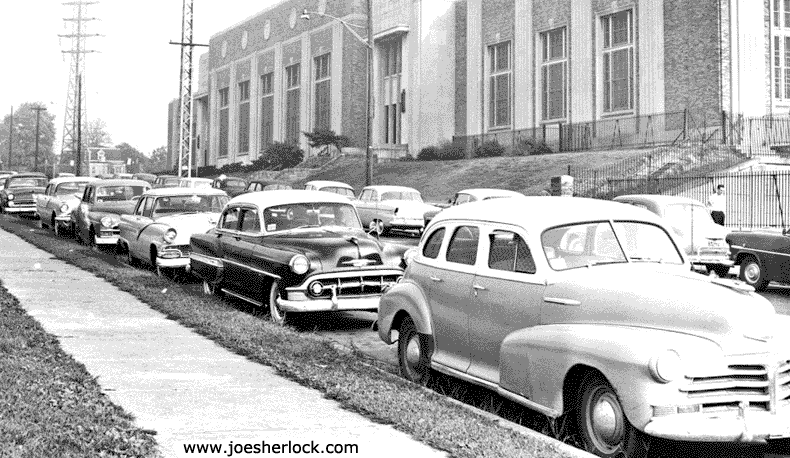
In the foreground is a tired-looking 1948 Chevrolet Fleetmaster four-door sedan, followed by a shiny 1953 Chevrolet Bel Air sedan, a 1957 Ford Fairlane Club Coupe with a V8 engine, a 1950 Plymouth De Luxe four-door sedan, a 1955 Pontiac Chieftan two-door sedan and a dark-colored, monotone 1955 Ford Customline sedan.
The photo is a good example of Philadelphia Graffiti, as opposed to American Graffiti which was set in sunny, car-crazy California. (posted 4/18/18, permalink)
More Face Not Needed: Auto parts retailer Pep Boys has suspended all advertising on Facebook following concerns about data privacy.
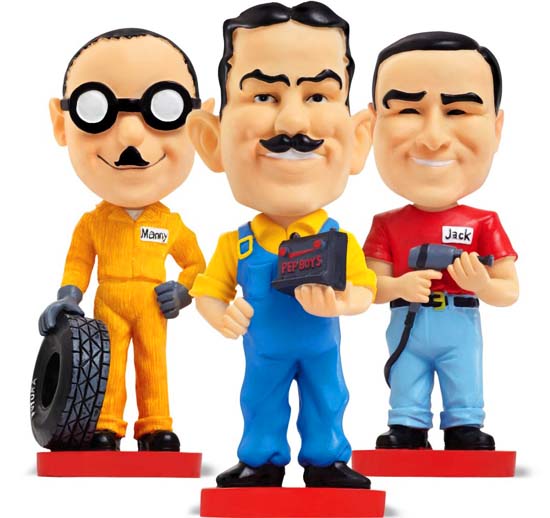
This shouldn't be a problem: Manny, Moe and Jack already have plenty-big faces. In 1921, Pep Boys started business in Philadelphia. I've written more about Pep Boys here. (posted 4/4/18, permalink)
The View From The El: Looking at some old Philadelphia photographs recently, I was reminded of the many times I rode the Frankford El - now designated the Frankford-Market Street Line - a rapid transit train which is elevated for much of the line and becomes a subway train in downtown. The line was completed in 1922.

In his excellent book, 'You Can't Get to Heaven on the Frankford El', author Tom Lyons relates stories about growing up in Northeast Philadelphia including riding on the old, dark-green rattly Frankford El train cars in the '40s and '50s.
I was a regular El patron from age 3 (when my mom would take me to a downtown department store to visit Santa Claus) until age 22 when I'd park my Corvette near the Bridge Street terminal and commute to evening post-grad classes at Drexel University.
Seeing an old photo of the Burpee Seed building in the Kensington section of Philadelphia made me recall that the red brick structure, with the company's slogan 'Burpee Seeds Grow', was visible when riding the El or when I hitched a ride with my high school buddies as we bounced along northbound Aramingo Avenue.
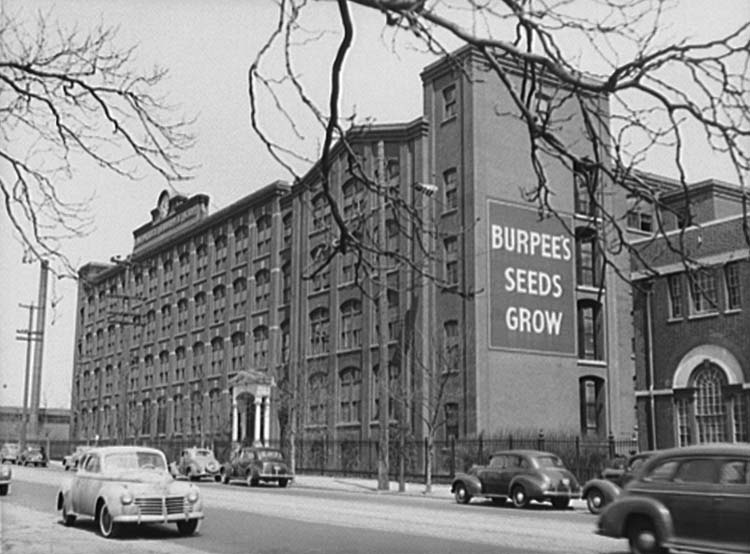
W. Atlee Burpee Company was founded in 1876 in Philadelphia. Mr. Burpee and his son, David, were pioneers in mail-order marketing. The 1891 catalog was the first to feature engravings made from photographs. Burpee's move to photography changed the whole mail-order industry and the hand-drawn illustration in catalogs disappeared. By 1915, the catalogs were 200 pages and a million were distributed. W. Atlee personally wrote most of the catalog copy and printed lots of customer testimonials - another pioneering move.
By the time Atlee died in 1915, the company had 300 employees and processed 10,000 orders a day. David Burpee sold the company in 1970 and the firm relocated to suburban Warminster, PA in 1974.
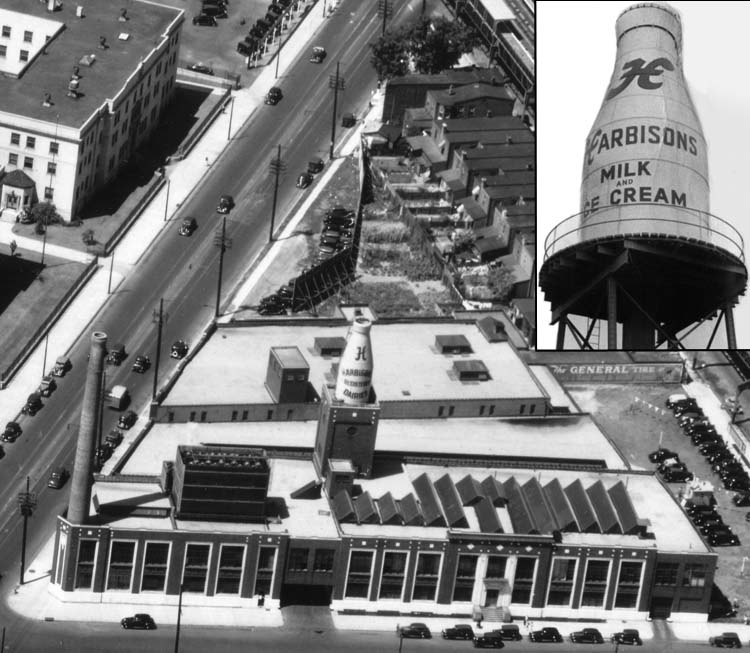
A prominent landmark visible from the Frankford El in East Kensington is the giant dairy milk bottle water tower at the former Harbison's Dairy building near the Erie-Torresdale El station. When Harbison's Dairy opened in 1865, milk trains from the farms would bring the fresh milk to the Dairy. The dairy closed in the mid-1960s but the giant bottle remains, although its appearance has deteriorated.
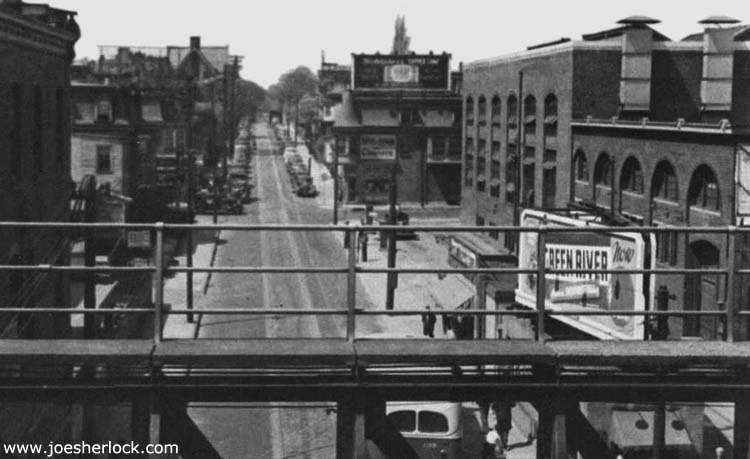
This 1941 photo was taken from the from the Frankford El platform at Margaret-Orthodox Station, looking west on Arrott Street. This area is now known as Arrott Transportation Center and is located at the intersection of Margaret St., Arrow St. Frankford Avenue and Oxford Ave. Orthodox Street is just up the block.
The building on the right side of the photo is a power station owned by the transit company; it was constructed by Philadelphia Rapid Transit Co. in the early 20th century.
The bus waiting for passengers is either the J or K bus. The J bus line went to from Frankford to Germantown while the K bus line traveled from Frankford to East Falls section of Philly. The trolley tracks were used by Route 75 which became a trackless trolley (trolley bus) in 1948. The 75 was a feeder line from the Frankford Elevated to the Broad St. Subway. When the 59 double-ended Brill trolleys on Route 59 were converted to trackless trolleys, the 59 route looped around Arrott Street, and after traveling a block or so looped back on Oxford Avenue in the other direction.
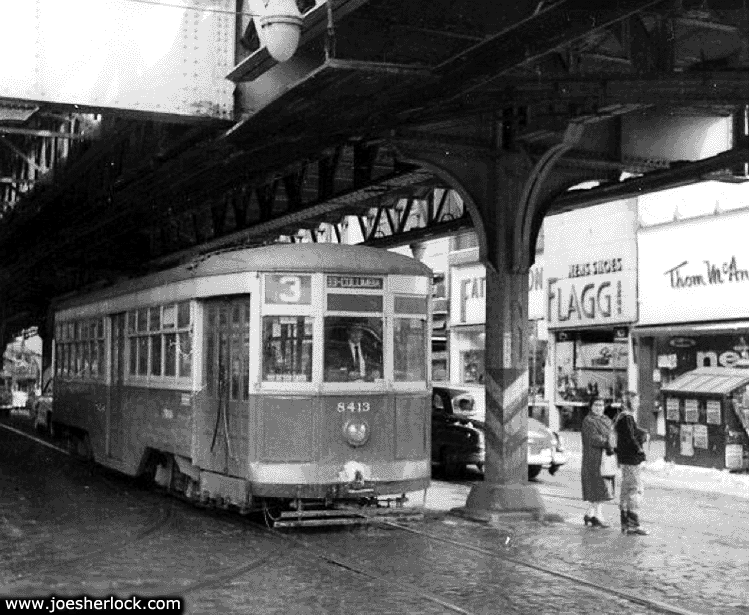
The Margaret-Orthodox area was transit-intensive - the Route 3 and Rte. 5 trolleys ran along Frankford Avenue underneath the elevated tracks. Route 3 used old-style Brill trolley cars; Route 5 used the newer streamlined PCC design. It should be noted that the historic Jolly Post Inn once stood near Frankford and Orthodox. This was the place where Thomas Jefferson was assigned the most important task of his life. The Continental Congress met in secret at the Jolly Post to decide who would write the Declaration of Independence. Sadly, the Jolly Post Inn was demolished in 1911 - all that remains is a plaque.
Whenever I took the El home from school, I'd get off at Margaret-Orthodox, traipse down the stairs and catch whatever transport was available - J bus, K bus or 75 trolleybus. All headed up Arrott Street to Castor Avenue, which was where I exited a mere two blocks from home.
I remember summer nights, when I was four years old, lying in bed with the windows open - trying to catch any breezy relief from Phily's heat and humidity - and hearing the far-away screech of the old Rte. 75 trolley's wheels against the rails as it as it made the sharp turn from Arrott St. on to Castor Avenue at Northwood Park.
That sound has stayed with me, even though the old Brill trolleys were gone by the time I turned five - replaced by quiet, more-maneuverable trackless trolleys:
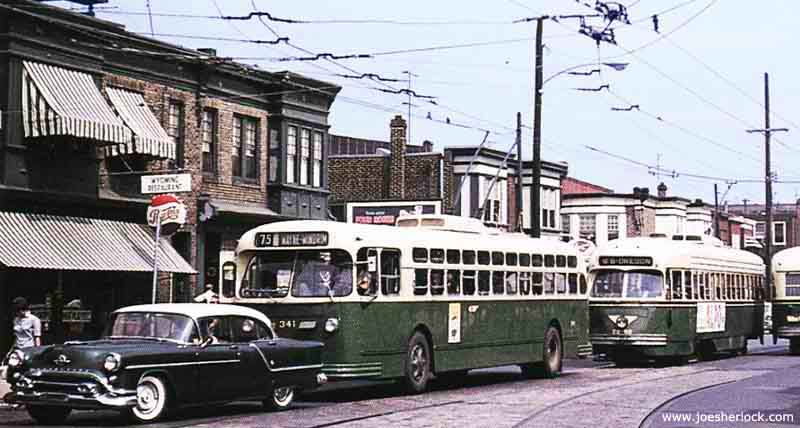
Old sounds and old photos trigger old memories - even seventy-plus years later. (posted 3/12/18, permalink)
"Well We're Living Here In Allentown ..." When I was growing up in Philadelphia, it seemed as if every truck I saw was a Mack. In those days, Mack was headquartered in Allentown, PA, about 60 miles north of Philly.
When I moved to the Pacific Northwest, Mack sightings became ... (more >>>)
Brought To You ... By Electricity: Electric trucks are in the news these days. Tesla, Navistar and others are developing all-electric delivery trucks, while UPS is converting 1,500 of its delivery vans to electric operation. Navistar has been testing its electric vehicles, which boast a 100-mile range, tight turning circle, and up to 4,400-pound payload with Federal Express.
Electric trucks have been around for over 100 years, produced by such firms as Columbia, Walker Vehicle Co., CT Electric and Frederick R. Wood & Sons.
Bakeries (including Philadelphia's Tasty Baking Co.), express companies and breweries also ran electric fleets. Many department stores used electric trucks for city deliveries. John Wanamaker employed such vehicles for its New York and Philadelphia stores, many made by ... (more >>>)
He-Man Sandwiches: That was the calling card of The Chuckwagon, a small restaurant chain located in the Philadelphia area. This cafeteria-style restaurant offered made-to-order, tall deli-style sandwiches (including pastrami and corned beef), sides, Panama jumbo shrimp, beef stew, and chili. Glass-front, refrigerated cases held beer (including a good selection of imported beers - a relative rarity in '50s-'60s Philly) and sodas.
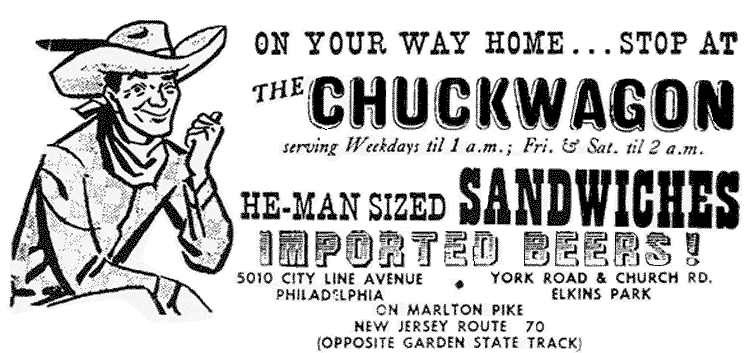
The exterior and interior decor was rustic, vaguely-Western themed. The outside didn't look that appealing by day, but had well-lit signage and looked a lot better at night, when I was there.
The Chuckwagon debuted in the mid-1950s and, eventually, grew to seven Delaware Valley locations: There in downtown Philadelphia (816 Chestnut St., 1818 Chestnut Street, 811 Sansom St.), West Philly at 40th and Walnut, 8040 Old York Road in Elkins Park, 50th and City Line Avenue in Overbrook and Marlton Pike (Route 70) across from the Garden State Park racetrack in South Jersey. I patronized the Elkins Park and City Line locations while in high school and college. Their medium-rare roast beef sandwiches were my favorite.
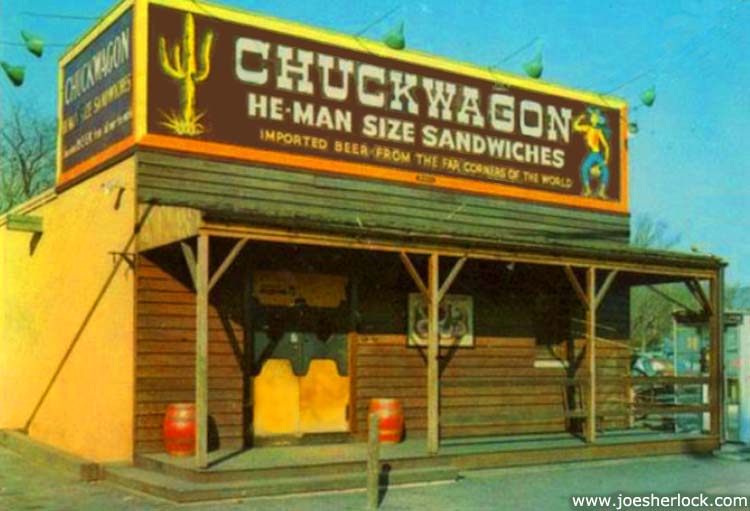
Sadly, the small chain disappeared in the 1970s; I'm not sure why. The food was always good, prices were reasonable and the locations I visited always seemed to be doing a brisk business. (posted 2/5/18, permalink)
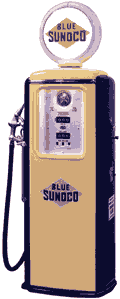 Shoulda Never Got Rid Of Those Dial-A-Grade Pumps: The largest oil refinery on the East Coast has filed for Chapter 11 bankruptcy protection. Shoulda Never Got Rid Of Those Dial-A-Grade Pumps: The largest oil refinery on the East Coast has filed for Chapter 11 bankruptcy protection.
The 335,000-barrel-per-day Philadelphia Energy Solutions (PES) refineries at Girard Point and Point Breeze employ about 1,100 people and supplies about 25% of the East Coast's refining capacity. PES acquired venerable brand Sunoco in 2012.
Sunoco is one of the largest fuel distribution companies in the United States, with Sunoco brand gasoline being sold in over 4,700 outlets spanning 26 states, just over a third hosting convenience stores.
The company has spent some $800 million in the past five years to comply with the U.S. Renewable Fuels Standard, a cost that critics say weighs on all refiners. For PES, the cost of the compliance with the standard was second only to crude oil costs on its expense sheet.
Once known as Sun Oil Co., the refiner was best known for its Sunoco 'custom blending pumps', an innovation that, beginning in 1958, allowed customers of Sunoco service stations to choose from several octane grades through a single gas pump. Sunoco stations offered five to eight octane grades of 'Custom Blended' gasolines from its Dial-A-Grade pumps which dispensed fuels ranging from cheapie Sunoco 190 to super-premium, 102 octane Sunoco 260.
'260' was very popular with '60s muscle car owners. (posted 1/26/18, permalink)
Mmm, Mmm, Good: One of the reasons that I read James Lileks is he reminds me about things I've forgotten. Recently, he took on the Campbell Kids. The Kids were especially well-known in Philadelphia because Campbell's Soup was just across the river in Camden, NJ. When I was growing up, the big tomato processing facility was located there as well. One of my high-school buddies, Eddie B., worked there unloading crates of Jersey tomatoes during the big August harvest. At the time, he lived in Pennsauken, not far from the Camden plant.
James Lileks asked, "What kid would ever want to play with the Campbell Kids?" Why not? Well, as James wrote, just "imagine yourself being chased by one of the Campbell Kids, its lidless eyes wide and startling. And needing."
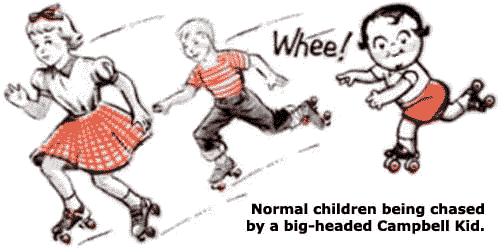
When you think about it (and I must admit that I hadn't done so before), they are kinda creepy. And what's the message from these chubby-faced children, anyway? Is it that too much soup makes your face fat?
The Kids consist of two boys and a girl. The boys looked a little light in the loafers and dressed like they were from 1920s Europe. Could they have been relatives of that chubby German exchange student, Üder, on 'The Simpsons'? In the episode where all the teachers at Springfield Elementary turned into cannibals, the cafeteria celebrated Octoberfest by featuring "Üderbratten."
And what about the Campbell girl? Did she look any better as a teenager? Probably not. What would you have done if she came up and asked you to her Junior Prom? Run, probably.
My daughter had Campbell Kids dolls as a toddler; she said that they weren't her favorite, remarking, "Those Campbell Kids' eyes are even more whacked out than I remember - i.e. - "I will eat nothing but Campbell soup for the rest of my life ..." said in a tranced voice. LOL."
Campbell's was started in 1869 by Joseph A. Campbell in Bridgeton, New Jersey. The firm produced canned tomatoes, vegetables, jellies, soups, condiments, and minced meats. Bridgeton and nearby Vineland were farm towns, best known for grapes, tomatoes and poultry. As the business grew, it moved to Camden, NJ.
The Campbell Soup Kids first appeared in 1905, when the company was still called the Joseph Campbell Company. They first appeared on the sides of streetcars and in magazine advertisements. They were so popular that the company licensed their images for dolls and other merchandise. The Campbell Kids were the Cabbage Patch Kids of the Teddy Roosevelt era.
Campbell's official line is that "the main object-in-life of these rollicking youngsters is to remind you of Campbell's Tomato Soup. To remind you that it is good for your own young people as well as the older ones; that its lively and enticing flavor adds to the enjoyment of life just as its wholesome equality helps you to promote good digestion and robust health." M-kay.
I'll end this soliloquy with a Little Known Fact: Ronald Reagan was a spokesman for V8 Juice when Campbell's acquired the brand in 1948. And that's the truth. (posted 1/12/18, permalink)
copyright 2018-21 - Joseph M. Sherlock - All applicable rights reserved
Disclaimer
The facts presented on this website are based on my best guesses and my substantially faulty geezer memory. The opinions expressed herein are strictly those of the author and are protected by the U.S. Constitution. Probably.
Spelling, punctuation and syntax errors are cheerfully repaired when I find them; grudgingly fixed when you do.
If I have slandered any brands of automobiles, either expressly or inadvertently, they're most likely crap cars and deserve it. Automobile manufacturers should be aware that they always have the option of giving me free cars to try and change my mind.
If I have slandered any people or corporations, either expressly or inadvertently, they should buy me strong drinks (and an expensive meal) and try to prove to me that they're not the jerks I've portrayed them to be. If you're buying, I'm willing to listen.
Don't be shy - try a bribe. It might help.
|